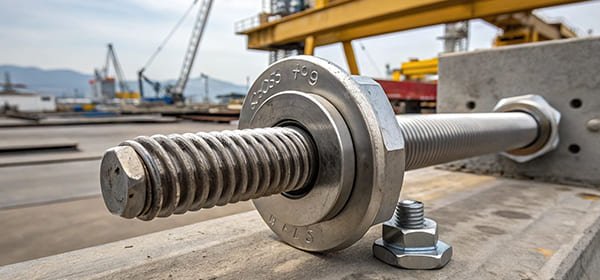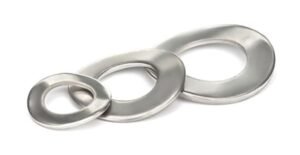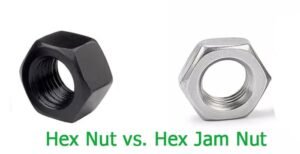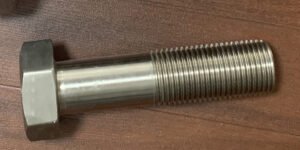
Washers are essential components in mechanical systems, ensuring the proper distribution of loads and preventing damage to surfaces. Selecting the right material and grade for your washers is critical for the longevity and performance of your machinery. In this article, we will dive into three commonly used washer grades — USS, SAE, and F436 — and explore their differences and applications in various industries.
The most commonly used washer grades include USS (W), SAE (N), and F436. USS washers, marked with “W”, are larger and typically made from low-carbon steel for general industrial applications. SAE washers, marked with “N”, are smaller and suited for lighter mechanical work. F436 washers are heat-treated for high-strength applications like bridges and heavy machinery.
Let’s now explore each of these washer grades in more detail, including their materials, dimensions, and typical applications.
USS Washers (United States Standard, W Grade)
USS washers are a type of low-carbon steel flat washer that follows the U.S. standard, with larger inner and outer diameters compared to SAE washers.
- Material: Typically made from low-carbon steel (unhardened steel), suitable for general fastening structures, offering strength and flexibility.
- Size Features: The outer diameter (OD) and inner diameter (ID) are larger, and the thickness is greater, providing more surface area, suitable for larger bolts and structures. The standard dimensions follow ASME B18.21.1.
- Application: USS washers are commonly used in mechanical connections, as spacers for bolts and nuts, helping distribute load and protect connecting surfaces from damage.
- USS washers also come in stainless steel versions (like 18-8 stainless/304 stainless steel) for applications requiring corrosion resistance.
USS washers also come in stainless steel versions (like 18-8 stainless/304 stainless steel) for applications requiring corrosion resistance.
- Example Size: For a 1/4″ bolt, the washer’s inner diameter is approximately 0.312″, the outer diameter is 0.734″, and the thickness is about 0.065″.
- Application Scenario: Suitable for general strength applications such as construction and machinery, helping to distribute load and protect connection surfaces.
SAE Washers (Society of Automotive Engineers, N Grade)
SAE washers are slightly smaller in size compared to USS washers, with a more compact inner and outer diameter.
- Material: Primarily made from low-carbon steel, commonly used in the automotive and mechanical industries, especially for lightweight applications.
- Size Features: SAE washers are thinner than USS washers, suitable for applications with limited space or lighter loads. The dimensions and thickness are standardized for easy mass production and interchangeability.
- Application: SAE washers are widely used in the automotive industry and in lightweight machinery.
SAE washers offer precise dimensional standardization, ensuring high consistency between components.
- Application Scenario: Especially suitable for automotive fasteners, ensuring efficient and reliable usage.
- Example Size: For a 1/4″ bolt, the washer’s inner diameter is approximately 0.281″, the outer diameter is 0.625″, and the thickness is about 0.0625″.
F436 Washers (ASTM F436)
F436 washers are high-strength, pressure-resistant washers defined by the U.S. ASTM standard, typically made from nickel-chromium-molybdenum alloy steel.
- Material: Mainly made from alloy steels (such as nickel-chromium-molybdenum), heat-treated (quenched and tempered) to enhance hardness and strength, offering high tensile strength and fatigue resistance.
- Strength Features: F436 washers are designed for heavy-duty applications where high load-bearing capacity is needed. They are commonly used in high-strength bolt connections, particularly in heavy industries.
F436 washers are ideal for high-demand mechanical structures, preventing fastener loosening and ensuring the structural strength and safety.
- Example Size: Similar to USS washers, a 1/4″ bolt washer has an inner diameter of approximately 0.312″, an outer diameter of approximately 0.734″.
- Application Scenario: Widely used in high-strength bolt connections for automotive, aerospace, and heavy industrial machinery.
USS Washers: Larger in size, suitable for general strength applications, providing more surface area for load distribution.
SAE Washers: More compact in size, ideal for lightweight or space-constrained applications.
F436 Washers: Heat-treated and high-strength, designed for demanding fastening connections.

Washer Comparison Table:
| Washer Type | Material | Size Features | Main Applications | Benefits |
|---|---|---|---|---|
| USS | Low-carbon steel / Stainless steel | Larger OD and ID, thicker | Mechanical connections, construction | Provides larger load distribution area, prevents surface damage |
| SAE | Low-carbon steel | Compact, thinner | Automotive, lightweight machinery | Precise dimensions, ideal for mass production |
| F436 | Alloy steel (Nickel-chromium-molybdenum) | High strength, heat-treated | High-strength structural connections | High tensile strength, fatigue resistance |
FAQ Section
1. What are the 4 types of washers?
There are four primary types of washers: flat washers, spring washers, fender washers, and locking washers. Each type serves a specific purpose, from load distribution to preventing vibration and securing fasteners. Understanding these differences ensures you’re selecting the right washer for the job.
2. What materials are commonly used for washers?
Common washer materials include stainless steel for corrosion resistance, carbon steel for strength, and brass for conductivity and corrosion resistance. Plastic washers are also used in non-metal applications. The material you choose depends on your needs for strength, resistance to corrosion, and durability.
3. How do spring washers differ from flat washers?
Spring washers are designed to provide tension to prevent fasteners from loosening under pressure or vibrations. They are often used in dynamic environments where the joint could shift. In contrast, flat washers are primarily used for load distribution and to prevent damage to surfaces during fastening.
4. What industries require specialized washers for performance?
Industries like automobile manufacturing, wind energy, oil & gas, and tower & pole manufacturing rely on washers made from specific materials like high-strength steel or corrosion-resistant alloys to ensure the safety and longevity of their products. Washers in these industries need to withstand extreme conditions such as high pressure, temperature, and corrosion.
Conclusion
Choosing the right washer is crucial for maintaining the integrity and safety of mechanical systems. From the large, durable USS washers to the specialized, high-strength F436 washers, understanding the differences in material and application helps ensure the performance of your projects. If you’re unsure which washer suits your needs, don’t hesitate to reach out for more guidance.
Contact Hengrui Fastener for Custom Washer
For specialized applications that require custom solutions, Hengrui Fastener offers high-quality, customizable washer and fasteners. Whether you need a specific size, material, or finish, Hengrui can provide tailored fasteners to meet your exact requirements. Contact Hengrui Fastener to learn more about our products and services.






